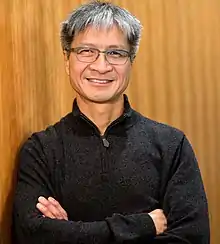Victor Peng
Victor Peng (born 1960) is a Taiwanese-American technology executive and CEO of Xilinx, an American technology company that supplies programmable logic devices.[1]
Victor Peng | |
|---|---|
 | |
| Born | 1960 (age 60–61) |
| Citizenship | American |
| Education | Bachelor of Engineering, Master of Engineering degree |
| Alma mater | Rensselaer Polytechnic Institute, Cornell University |
| Occupation | Chief Executive Officer |
| Years active | 1982-present |
| Employer | Xilinx |
| Spouse(s) | Debbie |
| Children | 3 |
| Website | www |
Career
Peng began his engineering career at Digital Equipment Corporation (DEC) in 1982. Then, from 1996 to 2008, he held several executive positions successively at Silicon Graphics, MIPS Technologies, Tzero Technologies, ATI and later AMD. He joined his current company Xilinx in January 2008.
From 1998 to 2004, Peng led the development of graphics processing units (GPUs) and multimedia products at MIPS Technologies. He joined ATI in 2005 before it was acquired by AMD. Then, he served as corporate Vice President of the graphics products group (GPG) silicon engineering at AMD. He also led AMD's central silicon engineering team supporting graphics, console game products, CPU chipset and consumer business units. Peng was also corporate Vice President of the graphics products group (GPG) silicon engineering at AMD until 2008.[2]
Peng successively held several C-level executive positions at the Programmable Products Group at Xilinx. He was responsible for the development and delivery of Xilinx programmable platforms including silicon and enabling technologies. He led the Programmable Platforms Development from November 2008 until April 2012. The following year, Peng served as the company Senior Vice President of programmable platforms group. From July 2014 to April 2017, Peng served as Senior Vice President and General manager of products at Xilinx, Inc. He was Chief Operating Officer at Xilinx from April 2017 and was appointed member of the board of directors in October of the same year.[3] On January 29, 2018, he was appointed the fourth company CEO and succeeded Moshe Gavrielov as part of an official succession plan.[4][5]
Peng received a Bachelor of Engineering from Rensselaer Polytechnic Institute and a Master of Engineering degree in electrical engineering from Cornell University. He holds four U.S. Patents[6][7][8] about engineering apparatus and methods from his work at Act-Rx Technology Corporation and Digital Equipment Corporation.[9][10]
References
- "Programmable chip maker Xilinx appoints Victor Peng as CEO". Venture Beat. January 4, 2018.
- "Executive Profile - Victor Peng". Bloomberg.
- "BRIEF-Xilinx announces multi-year succession plan and new COO". Reuters. April 12, 2017.
- "Xilinx CEO Gavrielov to Step Down This Month". EE Times. January 5, 2018.
- "Xilinx Names New Chief Executive Officer Victor Peng". Electronic Design. January 4, 2018.
- States7094039 United States 7094039, Kenny Hu, "Heat-dissipating fan", published August 22, 2006, assigned to Act-Rx Technology Corporation
- States4864527 United States 4864527, Victor Peng , & William J. Bowhill, "Apparatus and method for using a single carry chain for leading one detection and for "sticky" bit calculation", published September 5, 1989
- States4862405 United States 4862405, Bradley J. Benschneider, "Apparatus and method for expediting subtraction procedures in a carry/save adder multiplication unit", published August 29, 1989, assigned to Digital Equipment Corporation
- States4858165 United States 4858165, Paul E. Gronowski & Nachum M. Gavrielov, "Apparatus and method for acceleration of effective subtraction procedures by the approximation of the absolute value of the exponent argument difference", published August 15, 1989, assigned to Digital Equipment Corporation
- States4849923 United States 4849923, Sridhar Samudrala & Nachum M. Gavrielov, "Apparatus and method for execution of floating point operations", published July 18, 1989, assigned to Digital Equipment Corporation